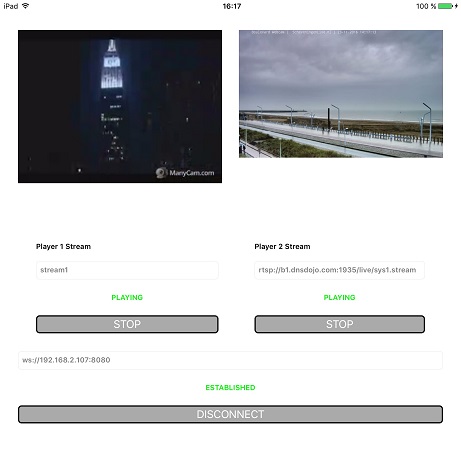iOS 2 Players¶
Example of iOS application with two players¶
This example demonstrates how two or more players can be displayed in one application. Each of the players can be used to play a different stream.

Analyzing the code¶
To analyze the code, let's take TwoPlayers example version, which is available here.
View class for the main view of the application: ViewController (header file ViewController.h; implementation file ViewController.m).
1. Import of API¶
2. Session creation¶
FPWCSApi2.createSession code
The options include:
- URL of WCS server
- appKey of internal server-side REST hook application (
defaultApp)
FPWCSApi2SessionOptions *options = [[FPWCSApi2SessionOptions alloc] init];
options.urlServer = _connectUrl.text;
options.appKey = @"defaultApp";
NSError *error;
FPWCSApi2Session *session = [FPWCSApi2 createSession:options error:&error];
3. Connection to the server¶
FPWCSApi2Session.connect code
4. Receiving the event confirming successful connection¶
FPWCSApi2Session.onConnected code
- (void)onConnected:(FPWCSApi2Session *)session {
[_connectButton setTitle:@"DISCONNECT" forState:UIControlStateNormal];
[self changeViewState:_connectButton enabled:YES];
[self onStopped1];
[self onStopped2];
}
5. Playback of video stream 1¶
FPWCSApi2Session.createStream, FPWCSApi2Stream.play code
Object with the following stream options is passed to createStream method:
- stream name
- view to display video
- (FPWCSApi2Stream *)play1Stream {
FPWCSApi2Session *session = [FPWCSApi2 getSessions][0];
FPWCSApi2StreamOptions *options = [[FPWCSApi2StreamOptions alloc] init];
options.name = _player1StreamName.text;
options.display = _player1Display;
NSError *error;
player1Stream = [session createStream:options error:nil];
...
if(![player1Stream play:&error]) {
UIAlertController * alert = [UIAlertController
alertControllerWithTitle:@"Failed to play"
message:error.localizedDescription
preferredStyle:UIAlertControllerStyleAlert];
UIAlertAction* okButton = [UIAlertAction
actionWithTitle:@"Ok"
style:UIAlertActionStyleDefault
handler:^(UIAlertAction * action) {
}];
[alert addAction:okButton];
[self presentViewController:alert animated:YES completion:nil];
}
return player1Stream;
}
6. Playback of video stream 2¶
FPWCSApi2Session.createStream, FPWCSApi2Stream.play code
Object with the following stream options is passed to createStream method:
- stream name
- view to display video
- (FPWCSApi2Stream *)play2Stream {
FPWCSApi2Session *session = [FPWCSApi2 getSessions][0];
FPWCSApi2StreamOptions *options = [[FPWCSApi2StreamOptions alloc] init];
options.name = _player2StreamName.text;
options.display = _player2Display;
NSError *error;
player2Stream = [session createStream:options error:nil];
...
if(![player2Stream play:&error]) {
UIAlertController * alert = [UIAlertController
alertControllerWithTitle:@"Failed to play"
message:error.localizedDescription
preferredStyle:UIAlertControllerStyleAlert];
UIAlertAction* okButton = [UIAlertAction
actionWithTitle:@"Ok"
style:UIAlertActionStyleDefault
handler:^(UIAlertAction * action) {
}];
[alert addAction:okButton];
[self presentViewController:alert animated:YES completion:nil];
}
return player2Stream;
}
7. Stream 1 playback stopping¶
FPWCSApi2Stream.stop code
- (void)player1Button:(UIButton *)button {
[self changeViewState:button enabled:NO];
if ([button.titleLabel.text isEqualToString:@"STOP"]) {
if ([FPWCSApi2 getSessions].count) {
NSError *error;
[player1Stream stop:&error];
} else {
NSLog(@"Stop playing, no session");
[self onStopped1];
}
...
}
}
8. Stream 2 playback stopping¶
FPWCSApi2Stream.stop code
- (void)player2Button:(UIButton *)button {
[self changeViewState:button enabled:NO];
if ([button.titleLabel.text isEqualToString:@"STOP"]) {
if ([FPWCSApi2 getSessions].count) {
NSError *error;
[player2Stream stop:&error];
} else {
NSLog(@"Stop playing, no session");
[self onStopped2];
}
...
}
}
9. Disconnection¶
FPWCSApi2Session.disconnect code
- (void)connectButton:(UIButton *)button {
[self changeViewState:button enabled:NO];
if ([button.titleLabel.text isEqualToString:@"DISCONNECT"]) {
if ([FPWCSApi2 getSessions].count) {
FPWCSApi2Session *session = [FPWCSApi2 getSessions][0];
NSLog(@"Disconnect session with server %@", [session getServerUrl]);
[session disconnect];
} else {
NSLog(@"Nothing to disconnect");
[self onDisconnected];
}
} else {
//todo check url is not empty
[self changeViewState:_connectUrl enabled:NO];
[self connect];
}
}
10. Receiving the event confirming successful disconnection¶
FPWCSApi2Session.onDisconnected code